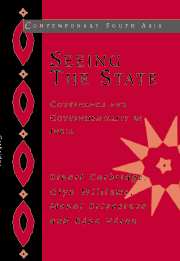Book contents
- Frontmatter
- Contents
- List of boxes, figures and tables
- Acknowledgements
- Glossary
- List of abbreviations
- Introduction
- Part I The state and the poor
- Part II The everyday state and society
- 3 Meeting the state
- 4 Participation
- 5 Governance
- 6 Political society
- Part III The poor and the state
- Appendix 1 Major national programmes and policies related to poverty alleviation, 1999
- Appendix 2 The 1999 general election in Hajipur
- References
- Index
3 - Meeting the state
Published online by Cambridge University Press: 22 September 2009
- Frontmatter
- Contents
- List of boxes, figures and tables
- Acknowledgements
- Glossary
- List of abbreviations
- Introduction
- Part I The state and the poor
- Part II The everyday state and society
- 3 Meeting the state
- 4 Participation
- 5 Governance
- 6 Political society
- Part III The poor and the state
- Appendix 1 Major national programmes and policies related to poverty alleviation, 1999
- Appendix 2 The 1999 general election in Hajipur
- References
- Index
Summary
Introduction
In this part of the book we draw on fieldwork in Bihar, Jharkhand and West Bengal to comment in more detail on how different actors come to see and engage the state in eastern India. chapters 4–6 offer different and yet complementary takes on what is necessarily an interlocking set of issues. In chapter 4 we consider why and how (and if) people participate in a range of ‘development’ schemes, including the Employment Assurance Scheme and Village Education Committees. These schemes make important assumptions about the construction of citizenship and civil society in rural India. In chapter 5 we direct our attention to the career paths of various government servants, and to the ways in which they construct working lives and practices that may or may not agree with the agendas of good governance now being promoted by New Delhi and the international development institutions. In chapter 6 we focus on the ways in which poorer people's encounters with the state are structured with close regard for the conventions of the political societies that operate in our study areas. We also take up the question of corruption here, as we do in chapter 5.
In this chapter we want to say something about the livelihoods and social networks of poorer people in our study areas. We will introduce some of the individuals (for example, brokers and ‘local uppers’) who become key figures in the stories we tell in chapters 4, 5 and 6, and we shall comment on the ways in which poorer men and women use their non-state social networks to access the state or keep it at a distance.
- Type
- Chapter
- Information
- Seeing the StateGovernance and Governmentality in India, pp. 87 - 120Publisher: Cambridge University PressPrint publication year: 2005



